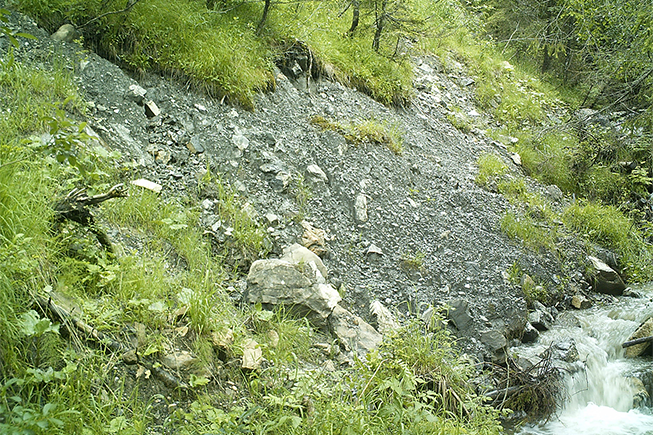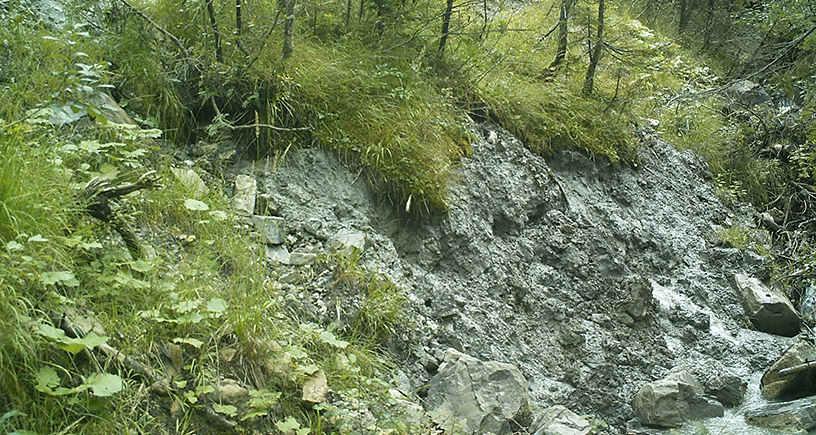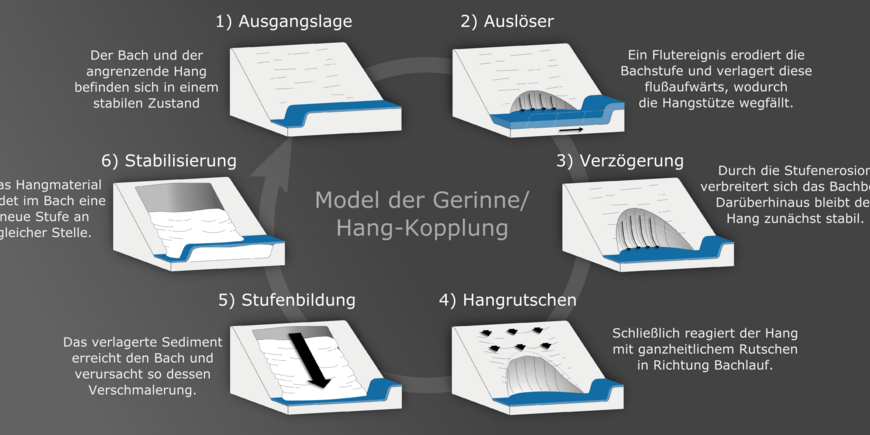Time-lapse video shows fascinating erosion dynamics in a river channel
27.01.2017: Rivers carry a lot of sediment which can potentially endanger infrastructure such as bridges or buildings. In order to improve risk assessment scientists investigate the processes of sediment transport. A team led by Antonius Golly from the GFZ German Research Centre for Geosciences presents direct observation of strong coupling between mountain channels and adjacent hillslopes. Their findings can help to estimate the time scales and the quantities of erosion and sediment load within rivers.
Golly and colleagues examined a channel step and an adjacent hillslope with a suspended landslide in the Erlenbach catchment in Switzerland. Monitoring was carried out using a camera system that takes a picture every 30 minutes over a number of weeks in 2014 and 2015 respectively. At the beginning, the 0.5 m high alluvial step in the alpine stream was stable, regardless of precipitation and water discharge. But then a heavy rainfall caused a larger flood resulting in strong erosion and a 4 m upstream migration of the step. Moreover, a bank failure ensued between the initial and the new step position as reported by the team in the GSA Journal Geology. A deep-seated hillslope motion was not apparent during this flood event. However, two days later, the hillslope entered a phase of integral motion. Subsequently the landslide refilled the stream bed until the original channel width was restored and the hillslope entered a stable condition again.
“Our monitoring data are direct observational evidence for the coupling of channels and hillslopes as proposed by previous studies based on indirect, large-scale terrain analyses and lab experiments”, says Antonius Golly of the GFZ’s section Geomorphology. “Our observations confirm that debuttressing by channel erosion can be a main cause of landslide activation.” This refutes the assumption that sediment delivery is mainly driven by the hydrology in the hillslope.
“Although the situation at the end of the cycle is quite similar to the initial state, sediment was delivered to the stream”, states Golly. Hence, this mechanism plays an important role for risk assessment. „Related hazards such as floods, mudflows and landslides can cause costs amounting to millions every year in Switzerland alone.” The scientists emphasize the importance of integrated channel-hillslope monitoring to improve the outcomes of risk analysis. The observed cycle is more common than one might think, explain the authors. The flood that triggered the hillslope failure in the Erlenbach had a recurrence interval of only 5 years. In other places such an event could happen even more frequently.
Original study:Golly, A., Turowski, J., Badoux, A., Hovius, N., 2017. Controls and feedbacks in the coupling of mountain channels and hillslopes. Geology, doi 10.1130/G38831.1
>>Link to "A time-lapse video of the erosion driven dynamics"; credit: A. Golly/GFZ in Geology










![[Translate to English:] Torsten Sachs in front of a climate station on a field](/fileadmin/_processed_/3/9/csm__TorstenSachs_bearbeitet_GS_4a1365ef84.jpeg)

![[Translate to English:] left image flood at the Ahrtal: image from above, several houses are flooded; left image:: Heidi Kreibich;](/fileadmin/_processed_/4/4/csm_Bild2_9af0130e9f.png)



![[Translate to English:] Start der Vega Rakete](/fileadmin/_processed_/6/4/csm_20231201-kachel_Vega-VV23-launch_ESA-CNES-Arianespace_706716b68c.jpeg)









![[Translate to English:] Poster exhibition at the Brandenburg Hydrogen Day at the GFZ, some participants in the foreground](/fileadmin/_processed_/6/5/csm_Erster_Brandenburgischer_Wasserstofftag_GFZ_402fcec95e.jpeg)
![[Translate to English:] Group picture of the participants](/fileadmin/_processed_/9/4/csm_20231108_CAWa-Workshop-Tashkent_Gruppenbild_99ea779d8a.jpeg)

![[Translate to English:] [Translate to English:] Hörsaal](/fileadmin/_processed_/e/6/csm_H%C3%B6rsal_e21ac645fb.jpeg)


![[Translate to English:] The Delegations in the Historic Library on the Telegrafenberg. In the back there are from left to right, the Dutch Ambassador for Germany, Ronald van Roeden, the Dutch Minister for Education, Culture and Science, Robbert Dijkgraaf and the scientific director of the GFZ, Susanne Buiter.](/fileadmin/_processed_/d/b/csm_Kachel-2_9eba4b4212.jpeg)

